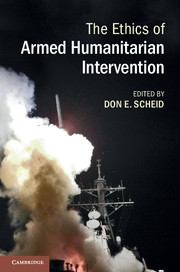Book contents
- Frontmatter
- Contents
- Notes on contributors
- Preface and acknowledgments
- List of abbreviations and acronyms
- Part I Intervention and debate
- Part II Moral perspectives
- 4 The moral basis of armed humanitarian intervention revisited
- 5 All or nothing
- 6 Judging armed humanitarian intervention
- 7 Bombing the beneficiaries
- Part III Ideas and reconsiderations
- Select bibliography
- Index
- References
7 - Bombing the beneficiaries
The distribution of the costs of the responsibility to protect and humanitarian intervention
Published online by Cambridge University Press: 05 June 2014
- Frontmatter
- Contents
- Notes on contributors
- Preface and acknowledgments
- List of abbreviations and acronyms
- Part I Intervention and debate
- Part II Moral perspectives
- 4 The moral basis of armed humanitarian intervention revisited
- 5 All or nothing
- 6 Judging armed humanitarian intervention
- 7 Bombing the beneficiaries
- Part III Ideas and reconsiderations
- Select bibliography
- Index
- References
Summary
Introduction
In its 1999 intervention in Kosovo, NATO was criticized heavily for its reliance solely on bombing from high altitude. Although NATO did not suffer any casualties itself, several civilians were reportedly killed by NATO’s sorties. One inference made was that NATO should have deployed ground troops and, in doing so, decreased harm to civilians by taking on greater costs itself. By relying on airpower alone, NATO – and the United States in particular – appeared to be too fearful of NATO soldiers coming home in body bags at the expense of innocent Kosovo Albanian and Serbian civilians. In other words, NATO placed all the human costs of the intervention on civilians.
NATO’s 2011 intervention in Libya also largely relied on airpower. This reliance on airpower was similarly controversial. On the one hand, as in Kosovo, there were no reported NATO casualties. Anders Fogh Rasmussen, the Secretary-General of NATO, claimed that “[w]e have carried out this operation very carefully, without confirmed civilian casualties.” But, on the other hand, an investigation in 2011 by The New York Times of airstrike sites found that “at least 40 civilians, and perhaps more than 70, were killed by NATO at these sites.” Again, it seems that NATO transferred much of the human costs of the intervention to civilians.
Keywords
- Type
- Chapter
- Information
- The Ethics of Armed Humanitarian Intervention , pp. 113 - 130Publisher: Cambridge University PressPrint publication year: 2014
References
- 5
- Cited by

